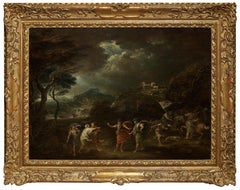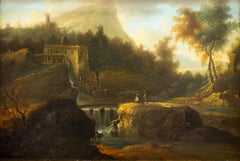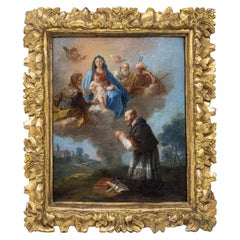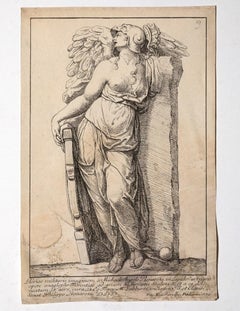Francesco Zuccarelli Art
to
1
4
4
4
4
1
1
Francesco Zuccarelli (Venetian master) - 18th century landscape painting
By Francesco Zuccarelli
Located in Varmo, IT
Francesco Zuccarelli (Pitigliano 1702 - Florence 1788) - River landscape with shepherds and herds.
31 x 46 cm without frame, 47.5 x 57 cm with frame.
Tempera on paper, in giltwood ...
Category
Mid-18th Century Rococo Francesco Zuccarelli Art
Materials
Tempera, Paper
Francesco Zuccarelli "Fishing Scene in a Landscape" Engraving 18th Century
By Francesco Zuccarelli
Located in Beuzevillette, FR
This magnificent engraving depicts a fishing scene in the middle of a landscape with lush vegetation. In the foreground of this scene is a man standing fishing. At his feet a young woman and a child are looking at the water. Further back on the right, there is another fishing scene, this time with two men. The whole is immersed in nature. In the background is a shepherd with a herd of cattle.
This scene was first painted by Francesco Zuccarelli. He was an 18th century painter and engraver. He began his training in Rome and then in Florence as a figure painter. Alter He moved to Venice. He was noticed for his talent in the art of landscape. He benefited from the protection of the English consul Joseph Smith, for whom he produced numerous works.
This engraving is made by Francesco Bartolozzi who is an engraver of the end of the 18th century and the beginning of the 19th century. He is an Italian who had 3 years of training in painting. But he finally devoted himself to engraving. He moved to Venice. He worked in the workshop of Joseph Wagner...
Category
Mid-18th Century Italian Antique Francesco Zuccarelli Art
Materials
Paper
F. Zuccarelli, Italianate Pastoral Scene, Large Impressive Engraving
By Francesco Zuccarelli
Located in Norwich, GB
An impressive large format engraving of an Italianate scene after Francesco Zuccarelli RA (1702-1788) engraved by François Vivares (1709-1780).
Very much of the late Baroque or Ro...
Category
1750s Italian George II Antique Francesco Zuccarelli Art
Materials
Paper
Macbeth and the Three Witches a Painting on Panel by Francesco Zuccarelli
By Francesco Zuccarelli
Located in PARIS, FR
This painting, created during Zuccarelli's stay in England, represents the decisive moment when Macbeth, together with Banquo, meets the three witches who announce that he will be Ki...
Category
1760s Old Masters Francesco Zuccarelli Art
Materials
Oil, Wood Panel
Related Items
Baroque Dutch painter - Late 18th century figure painting - Inn Interior - Oil o
Located in Varmo, IT
Dutch painter (18th-19th century) - The spanking.
60 x 99 cm without frame, 67 x 106 cm with frame.
Antique oil painting on wood, without frame.
Condition report: Wooden support s...
Category
Late 18th Century Old Masters Francesco Zuccarelli Art
Materials
Oil, Panel
Italian Landscape With Figures at a Waterfall by a Follower of Jan van Huysum
By Jan Van Huysum
Located in Stockholm, SE
There are so many details to fall in love with in this 18th-century painting depicting an Italianate landscape, for example, the delicately painted figures having a conversation and ...
Category
Early 18th Century Old Masters Francesco Zuccarelli Art
Materials
Wood Panel, Oil
Free Shipping
H 9.65 in W 13.98 in
The Road by Valérie de Sarrieu - Oil on canvas painting, landscape
Located in Paris, FR
The Road is a unique oil on canvas painting by contemporary artist Valérie de Sarrieu, dimensions are 160 × 160 cm (63 × 63 in).
The artwork is signed, sold unframed and comes with a...
Category
2010s Contemporary Francesco Zuccarelli Art
Materials
Canvas, Paper, Oil, Tempera
Shipping in Stormy Waters, Attributed to Italian Artist Francesco Guardi
By Francesco Guardi
Located in Stockholm, SE
The splendour of the tragic sea
Francesco Guardi and maritime painting in Venetian art
No Venetian painter was a stranger to the sea. After all, Venice was not only one of the most prominent ports of the Mediterranean, but indeed a city literally submerged in the ocean from time to time. Curiously however, the famous Venetian school of painting showed little interest in maritime motifs, favouring scenes from the iconic architecture of the city rather than seascapes. That is why this painting is a particularly interesting window into not only the painter Francesco Guardi himself – but to the significance of the element of water in art history, in absence as well as in the centre of attention.
Whether it be calm, sunny days with stunning views of the palaces alongside the canals of Venice or – more rarely – stormy shipwrecking tragedies at sea, water as a unifying element is integral to the works of painter Francesco Guardi (1712–1793). During his lifetime, Venetian art saw many of its greatest triumphs with names like Tiepolo or Canaletto gaining international recognition and firmly establishing Venice as one of the most vibrant artistic communities of Europe. While the city itself already in the 18th century was something of an early tourist spot where aristocrats and high society visited on their grand tour or travels, the artists too contributed to the fame and their work spread the image of Venice as the city of romance and leisure to an international audience, many of whom could never visit in person.
Still today, the iconic image of Venice with its whimsical array of palaces, churches and other historic buildings is much influenced by these artists, many of whom have stood the test of time like very well and remain some of the most beloved in all of art history. It was not primarily subtility, intellectual meanings or moral ideals that the Venetian art tried to capture; instead it was the sheer vibrancy of life and the fast-paced city with crumbling palaces and festive people that made this atmosphere so special. Of course, Venice could count painters in most genres among its residents, from portraiture to religious motifs, history painting and much else. Still, it is the Vedutas and views of the city that seems to have etched itself into our memory more than anything else, not least in the tradition of Canaletto who was perhaps the undisputed master of all Venetian painters.
Born into his profession, Francesco lived and breathed painting all his life. His father, the painter Domenico Guardi (1678–1716) died when Francesco was just a small child, yet both he and his brothers Niccolò and Gian Antonio continued in their fathers’ footsteps. The Guardi family belonged to the nobility and originated from the mountainous area of Trentino, not far from the Alps. The brothers worked together on more challenging commissions and supported each other in the manner typical of family workshops or networks of artists. Their sister Maria Cecilia married no other than the artist Giovanni Battista Tiepolo himself, linking the family to the most renowned Venetian name of the time. During almost a decade, Guardi worked in the studio of Michele Giovanni Marieschi, sometimes simply known as Michiel, a painted similar in both style and motif. Canaletto is, however, the artist Guardi is most often compared to since they shared a mutual fascination for depicting the architecture and cityscape of Venice.
During the course of his career, Guardi tried his hand in many different genres. He was as swift in painting landscapes, Vedutas of Venice, sacred motifs, interiors and architectural compositions as he was in a number of other motifs. His style is typical of the Venetian school but also distinct and personal once we look a little closer. There is an absolute certainty in the composition, the choice of which sometimes feels like that of a carefully calculated photograph – yet it is also very painterly, in the best sense of the word: fluid, bold, sensitive and full of character. The brushwork is rapid, intense, seemingly careless and extraordinarily minute at the same time; fresh and planned in a very enjoyable mixture. His interiors often capture the breath-taking spacious glamour of the palaces and all their exquisite decor. He usually constructed the motif through remarkably simple, almost spontaneous yet intuitively precise strokes and shapes. The result was a festive, high-spirited atmospheric quality, far away from the sterile and exact likeness that other painters fell victim to when trying to copy Canaletto.
The painting here has nothing of the city of Venice in it. On the contrary, we seem to be transported far away into the solitary ocean, with no architecture, nothing to hold on to – only the roaring sea and the dangerous cliffs upon which the ships are just moments away from being crushed upon. It is a maritime composition evoking both Flemish and Italian precursors, in the proud tradition of maritime painting that for centuries formed a crucial part of our visual culture.
This genre of painting is today curiously overlooked, compared to how esteemed and meaningful it was when our relationship to the sea was far more natural than it is today. When both people and goods travelled by water, and many nations and cities – Venice among them – depended entirely on sea fare, the existential connection to the ocean was much more natural and integrated into the imagination. The schools and traditions of maritime art are as manifold as there are countries connected to the sea, and all reflect the need to process the dangers and wonders of the ocean.
It could symbolize opportunity, the exciting prospects of a new countries and adventures, prospering trade, beautiful scenery as well as war and tragedy, loss of life, danger and doom. To say that water is ambivalent in nature is an understatement, and these many layers were something that artists explored in the most wondrous ways. Perhaps it takes a bit more time for the modern eye to identify the different nuances and qualities of historic maritime paintings, they may on first impression seem hard to differentiate from each other. But when allowing these motifs to unfold and tell stories of the sea in both fiction and reality – or somewhere in between – we are awarded with an understanding of how the oceans truly built our world.
In Guardi’s interpretation, we see an almost theatrically arranged shipwrecking scene. No less than five ships are depicted right in the moment of utter disaster. Caught in a violent storm, the waves have driven them to a shore of sharp cliffs and if not swallowed by the waves, crushing against the cliffs seems to be the only outcome. The large wooden ships are impressively decorated with elaborate sculpture, and in fact relics already during Guardi’s lifetime. They are in fact typical of Dutch and Flemish 17th century ships, giving us a clue to where he got the inspiration from. Guardi must have seen examples of Flemish maritime art, that made him curious about these particular motifs. One is reminded of Flemish painters like Willem van de Velde and Ludolf Backhuysen, and this very painting has indeed been mistakenly attributed to Matthieu van Plattenberg...
Category
18th Century Old Masters Francesco Zuccarelli Art
Materials
Canvas, Oil
Free Shipping
H 25.79 in W 29.14 in
Antique English 19th century marine scene
By William Anderson
Located in Woodbury, CT
Outstanding English late 18th / early 19th century marine scene by one of Britain's best known and sought after painters.
William (or Wiliam) Anderson (1757 – 27 May 1837) was a Scottish artist specializing in maritime and patriotic themes. He was well-regarded for his detailed and accurate portraits of ships under sail, exhibiting his works annually in London between 1787 and 1811 and then occasionally until 1834. Anderson influenced other artists, notably John Ward and others of the Hull school.
Anderson's early life is obscure, but he is known to have trained as a shipwright before moving to London to become a maritime painter when he was about 30. His training served him well as a painter, providing "a practical nautical knowledge" of his subjects. He earned a reputation for "accuracy and refinement of detail" and was admired for his bright, clear colours. He worked in both oils and watercolours.
He based his style on that of well-known Dutch maritime...
Category
1810s Old Masters Francesco Zuccarelli Art
Materials
Oil, Wood Panel
Dutch School, 17th Century, Shipping in a Stiff Breeze, a City Beyond
Located in Stockholm, SE
We are delighted to present a significant piece from the Dutch School, most likely dating back to the late 17th century. This captivating painting showcases the dynamic force of nature with three ships vigorously navigating through stormy waters. The foreground is a scene of nautical struggle, as figures are depicted working intensely with the sails, steering, and bracing against the tumultuous sea.
In the serene background, the silhouette of a quaint town emerges, with spires from churches and the outlines of various buildings is visible. This juxtaposition of the calm town against the chaotic foreground serves as a powerful reminder of the unpredictability of life and nature.
Dominating the canvas, the sky occupies two-thirds of the painting, filled with brooding clouds that occasionally break to reveal patches of blue. The presence of birds adds a dynamic element to the otherwise ominous atmosphere.
While the artist remains unknown, the work is quintessentially Dutch in its execution, with meticulous attention to detail and a profound understanding of maritime life. The painting's oval shape is quite distinctive and is complemented by a suitably antique octagonal black frame, which adds to its historical charm.
This piece is a testament to the mastery of Dutch maritime painting...
Category
17th Century Old Masters Francesco Zuccarelli Art
Materials
Oak, Oil, Wood Panel
Five mid 20th century Italian oil landscapes with figures, castles, Churchs
Located in Woodbury, CT
A very interesting set of five mid-20th-century Italian oils on copper.
All five are classical landscape subjects and are signed Roger, though we don't know which artist with the n...
Category
1950s Old Masters Francesco Zuccarelli Art
Materials
Copper
Free Shipping
H 7 in W 5 in
Ascension Day in Venice, Louis de Caullery (1582-1621), Flemish 17th century
Located in PARIS, FR
Ascension Day in Venice
17th century Antwerp School
Attributed to Louis de Caullery (1582-1621)
Oil on oak panel
Dimensions: h. 19.68 in, w. 34.25 in
Flemish style frame in ebonized ...
Category
Early 17th Century Old Masters Francesco Zuccarelli Art
Materials
Oil, Wood Panel
Antique Rococo Oil Painting, around 1800, "Royal Dance in the Garden"
Located in Berlin, DE
Antique Rococo Oil Painting, around 1800, Royal Dance in the Garden
Oil on canvas.
Canvas relined. Stretcher renewed.
Dimensions are without fra...
Category
18th Century Rococo Francesco Zuccarelli Art
Materials
Canvas, Oil
Free Shipping
H 15.75 in W 19.69 in
"Woman Listening, " Honore Sharrer, Magical Realism Landscape with Flora & Figure
By Honore Sharrer
Located in New York, NY
Honore Sharrer (1920 - 2009)
Woman Listening
Signed lower right
Caseine on paper
15 x 20 inches
Provenance:
Forum Gallery, New York
Private Collection
...
Category
Late 20th Century American Realist Francesco Zuccarelli Art
Materials
Paper, Casein
Antique Early Engraving of Classical Scene in Giltwood Frame, Dated 1842
Located in Big Flats, NY
Antique Early Engraving of Classical Scene with Figures Seated in Giltwood Frame, Dated 1842
Measures - 26.75" x 27.25" x 1.25
Category
Mid-19th Century Antique Francesco Zuccarelli Art
Materials
Paper
H 26.75 in W 27.25 in D 1.25 in
Art Deco Woman in Classical Robes set in Stylized Landscape
Located in Miami, FL
Woman in Surreal Landscape Illustration
Published: Woman's Home Companion December 1939, "How to Pray"
By Ralph Sadler Meadowcroft
Work is Unframed
Category
1930s Art Deco Francesco Zuccarelli Art
Materials
Tempera
Previously Available Items
18th Century Vision of San Filippo Neri Painting Oil on Copper by Zuccarelli
By Francesco Zuccarelli
Located in Milan, IT
Francesco Zuccarelli (Pitigliano, 1702 - Florence, 1788)
Vision of S. Filippo Neri
Oil on copper, 26 x 22 cm; with frame 35 x 31 cm
On the back it bea...
Category
18th Century Italian Antique Francesco Zuccarelli Art
Materials
Copper
H 13.78 in W 12.21 in D 1.58 in
After Michelangelo - Original Etching by Francesco Zuccarelli - 1750
By Francesco Zuccarelli
Located in Roma, IT
After Michelangelo Buonarroti is an original Modern artwork realized by Francesco Zuccarelli (Piticciano, 1702 - Florence, 1779).
Original Etching on paper.
Inscripted on plate on...
Category
1750s Francesco Zuccarelli Art
Materials
Etching
H 8.08 in W 5.52 in D 0.04 in
L'Angelo Custode (The Guardian Angel)
By Francesco Zuccarelli
Located in Saint Augustine, FL
An original copper plate engraving on laid paper by Italian artist Francesco Zuccarelli (1702-1788) titled "L'Angelo Custode (Guardian Angel), 1742.
Francesco Zuccarelli, (1702–1...
Category
18th Century and Earlier Old Masters Francesco Zuccarelli Art
Materials
Engraving
Francesco Zuccarelli art for sale on 1stDibs.
Find a wide variety of authentic Francesco Zuccarelli art available for sale on 1stDibs. You can also browse by medium to find art by Francesco Zuccarelli in paint, oil paint, panel and more. Much of the original work by this artist or collective was created during the 18th century and is mostly associated with the Old Masters style. Not every interior allows for large Francesco Zuccarelli art, so small editions measuring 23 inches across are available. Customers who are interested in this artist might also find the work of Sir Godfrey Kneller, Jan Frans van Bloemen (Orizzonte), and Giulio Di Sotto. Francesco Zuccarelli art prices can differ depending upon medium, time period and other attributes. On 1stDibs, the price for these items starts at $5,385 and tops out at $55,000, while the average work can sell for $30,192.






